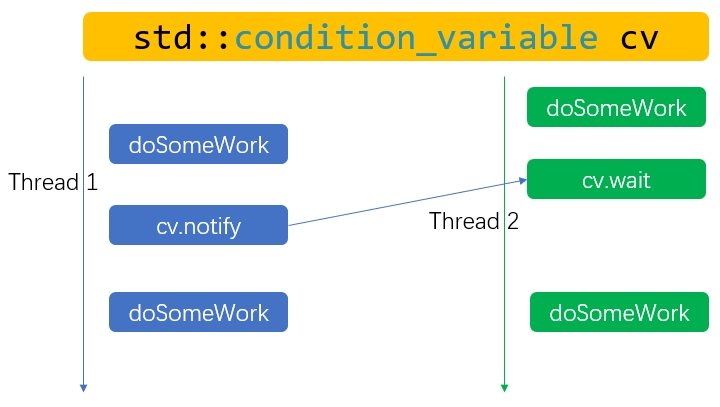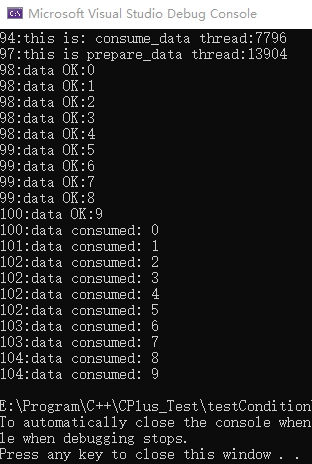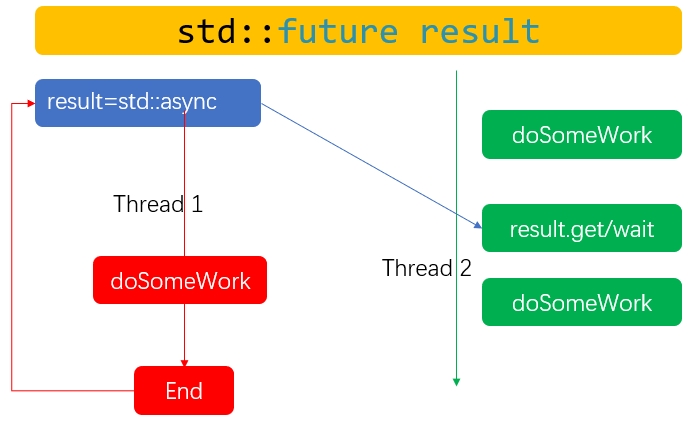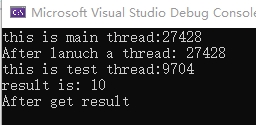
我们提供安全,免费的手游软件下载!
条件变量std::condition_variable是C++中用于线程间同步的重要工具,它提供了wait和notify接口。下图展示了Thread 2在wait接口阻塞,而Thread 1通过notify接口通知Thread 2继续执行。

以下是示例代码:
#include
#include
#include
#include
std::mutex mt;
std::queue data;
std::condition_variable cv;
auto start=std::chrono::high_resolution_clock::now();
void logCurrentTime()
{
auto end = std::chrono::high_resolution_clock::now();
auto elapsed = std::chrono::duration_cast(end - start).count();
std::cout << elapsed << ":";
}
void prepare_data()
{
logCurrentTime();
std::cout << "this is " << __FUNCTION__ << " thread:" << std::this_thread::get_id() << std::endl;
for (int i = 0; i < 10; i++)
{
data.push(i);
logCurrentTime();
std::cout << "data OK:" << i << std::endl;
}
//start to notify consume_data thread data is OK!
cv.notify_one();
}
void consume_data()
{
logCurrentTime();
std::cout << "this is: " << __FUNCTION__ << " thread:" << std::this_thread::get_id() << std::endl;
std::unique_lock lk(mt);
//wait first for notification
cv.wait(lk); //it must accept a unique_lock parameter to wait
while (!data.empty())
{
logCurrentTime();
std::cout << "data consumed: " << data.front() << std::endl;
data.pop();
}
}
int main()
{
std::thread t2(consume_data);
//wait for a while to wait first then prepare data,otherwise stuck on wait
std::this_thread::sleep_for(std::chrono::milliseconds(10));
std::thread t1(prepare_data);
t1.join();
t2.join();
return 0;
}

主线程中另启两个线程,分别执行consume_data和prepare_data。其中consume_data需要先执行,以确保先等待再通知,否则若先通知再等待就会发生死锁。首先consume_data线程在wait处阻塞等待。后prepare_data线程中依次向队列写入0-10,写完之后通过notify_one通知consume_data线程解除阻塞,依次读取0-10。
std::future与std::async配合使用,实现异步执行代码,并通过wait或get接口阻塞当前线程等待结果。下图展示了Thread 2中future接口的get或wait接口会阻塞当前线程。std::async异步开启的新线程Thread1执行结束后,将结果存于std::future后通知Thread 1获取结果后继续执行。

以下是示例代码:
#include
#include
#include
int test()
{
std::cout << "this is " << __FUNCTION__ << " thread:" << std::this_thread::get_id() << std::endl;;
std::this_thread::sleep_for(std::chrono::microseconds(1000));
return 10;
}
int main()
{
std::cout << "this is " <<__FUNCTION__<<" thread:" << std::this_thread::get_id() << std::endl;;
//this will lanuch on another thread
std::future result = std::async(test);
std::cout << "After lanuch a thread: "<< std::this_thread::get_id() << std::endl;
//block the thread and wait for the result
std::cout << "result is: " <

主程序中调用std::async异步调用test函数。可以看到main函数的线程ID 27428与test函数执行的线程ID 9704并不一样,说明std::async另起了一个新的线程。在test线程中,先sleep 1000ms,所以可以看到"After lanuch a thread:"先输出,说明主线程异步执行,不受子线程影响。而"After get result "最后输出,说明get()方法会阻塞主线程,直到获取结果。
热门资讯